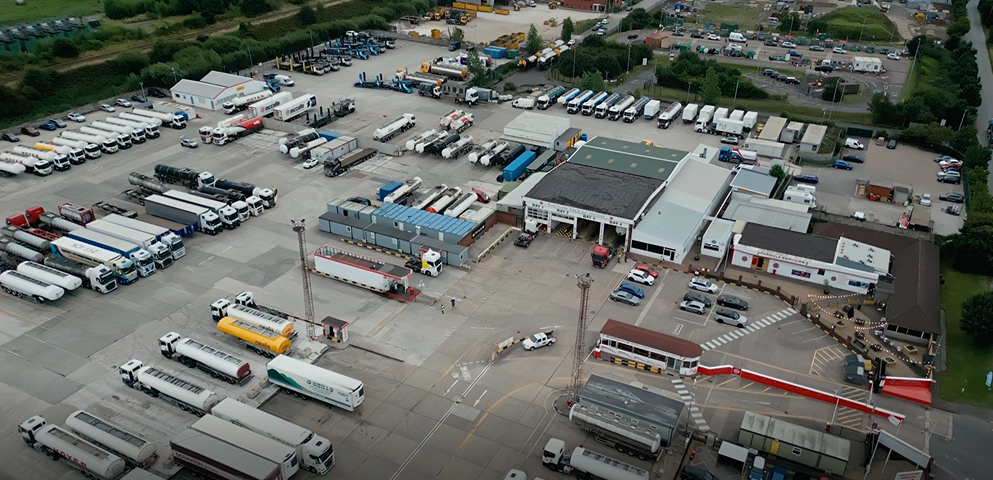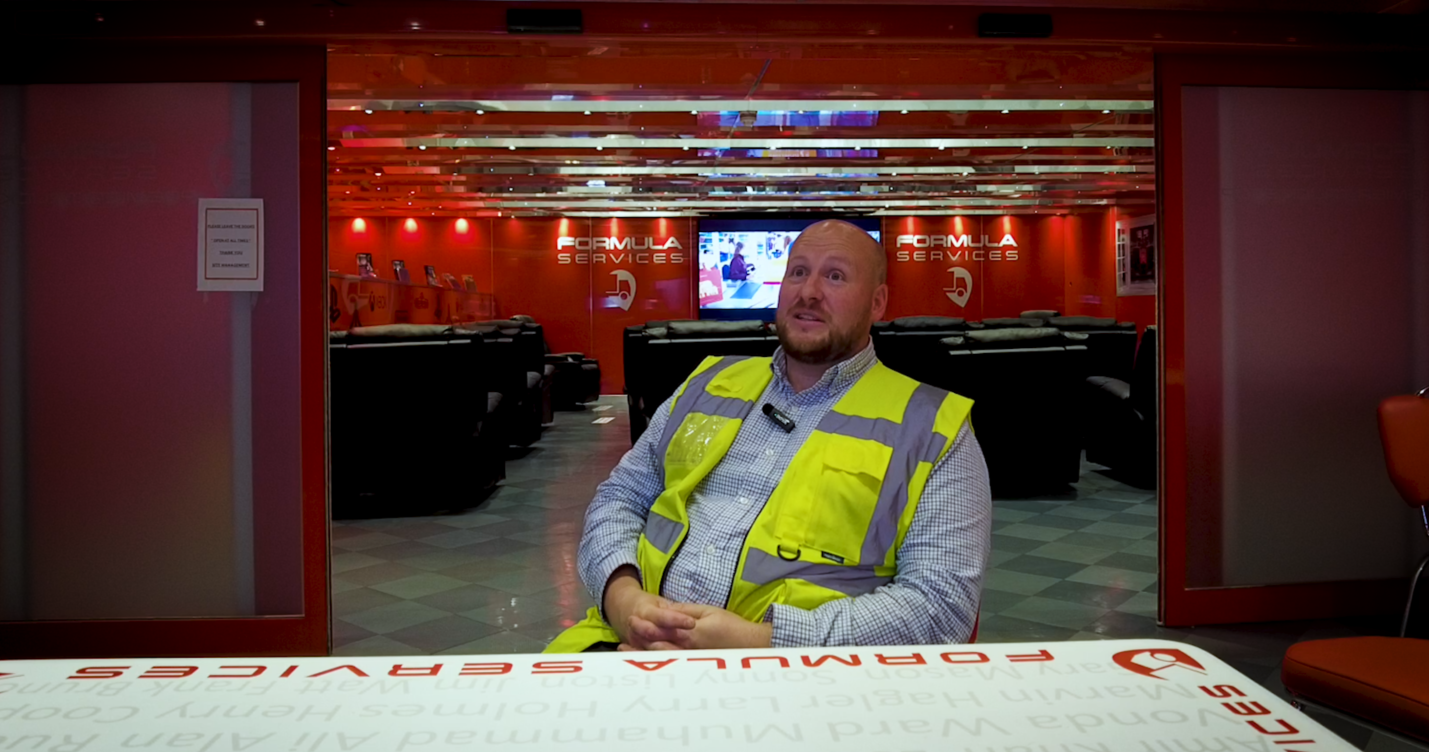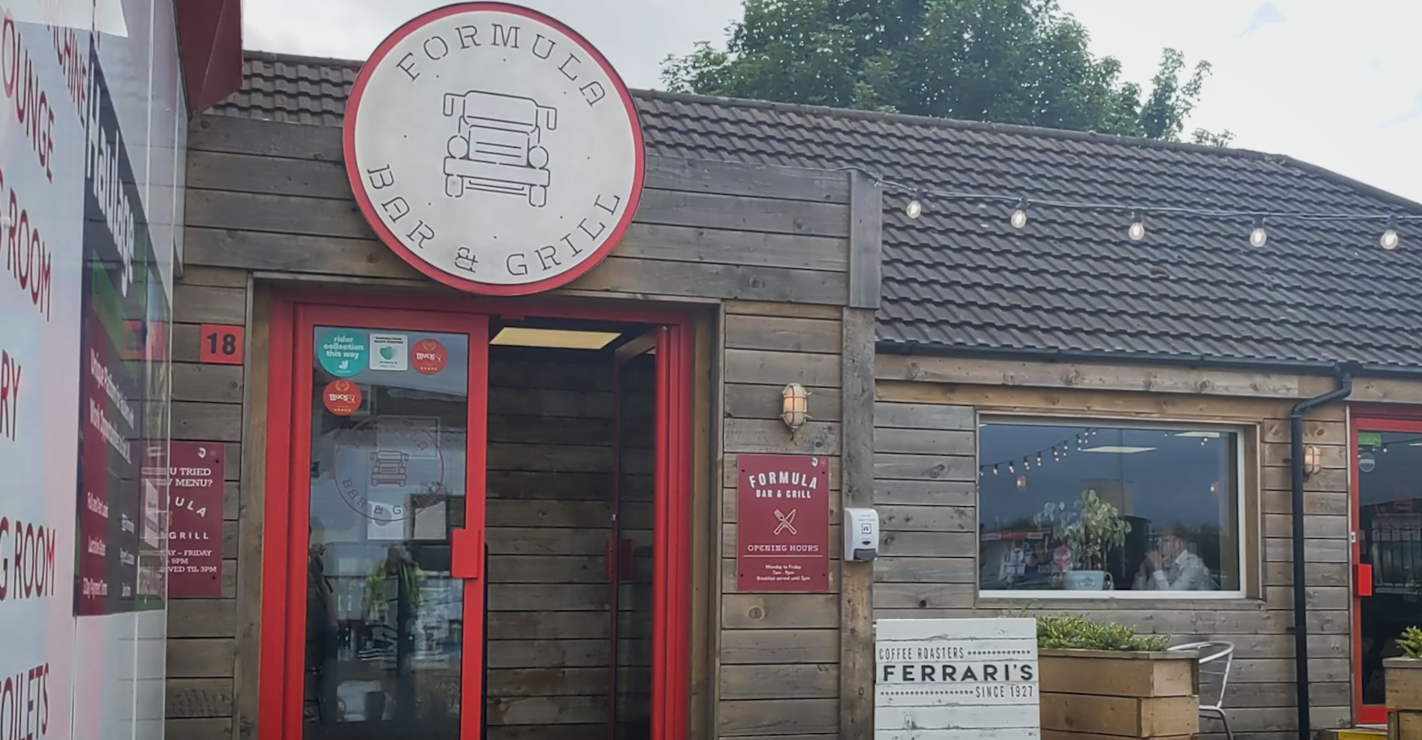
Susie Jones
Inside Formula Premier Truckstop: Erforschung des Erfolgs und der Beziehung zu SNAP
Erstellt: 07.08.2025
•
Aktualisiert: 07.08.2025
In Ellesmere Port, nur einen Steinwurf von der M53 entfernt, befindet sich [Formula Premier Truckstop] (https://www.formulaservices.co.uk/). Der Standort wurde zum Truckstop des Jahres 2023 in Großbritannien gewählt und hat sich in der Lkw-Gemeinschaft zu einem festen Favoriten entwickelt. Als Hommage an die Verbindung zur Formel 1 (der Standort versorgte einst Rennwagen auf der ganzen Welt mit Treibstoff) ist der Truckstop in das ikonische Rot getaucht und bietet eine Fülle von sportlichen Erinnerungsstücken, die die Besucher stundenlang beschäftigen.
Anlässlich des 10-jährigen Jubiläums haben wir uns mit Betriebsleiter Ash Evans zusammengesetzt, um alles zu besprechen - von neuen Einrichtungen und Nachhaltigkeitszielen bis hin zum Wohlergehen der Fahrer und ihrer Beziehung zu SNAP.
Wir sind seit 10 Jahren als Truckstop tätig. Wir stehen allen Lkw-Fahrern offen, ob groß oder klein, ob Sattelschlepper oder Arktis. Wir haben eine Tankstelle, die geöffnet ist, solange man eine Tankkarte hat ", erklärt Ash.

Einrichtungen
Der Standort verfügt über eine Reihe von fantastischen Einrichtungen, die den Lkw-Fahrern ein Zuhause fernab der Heimat bieten.
Wir haben etwa 150 Parkplätze, ein Restaurant, einen Fitnessraum und eigene Waschräume für Männer und Frauen. Wir versuchen, so viel wie möglich in den Preis für das Parken einzubeziehen ", erklärt Ash.
Bei unserem Rundgang über das Gelände kommen wir an einem speziellen Spielzimmer vorbei, das mit einem Billard- und einem Tischtennistisch, einem Lounge-Bereich mit Massagesesseln und einer Vielzahl von Spielkonsolen ausgestattet ist, die den Fahrer nach einer langen Schicht entspannen. Auf der praktischen Seite bietet der Standort Waschmöglichkeiten, einen Fitnessraum und einen Küchenbereich, in dem man sich selbst Mahlzeiten zubereiten kann. Wer nach einem Tag am Steuer keine Lust hat zu kochen, kann das hauseigene Restaurant nutzen, das jetzt auch SNAP-Essensgutscheine anbietet.
Sie sind immer auf der Suche nach Möglichkeiten, den Standort zu verbessern. Die Einrichtungen, die sie haben, sind ein angenehmer Ort für die Fahrer. Es macht die Fahrt eines Fahrers viel sicherer und einfacher, wenn er weiß, dass er am Ende der Fahrt diese Art von Einrichtungen vorfindet. "
- Stuart Willetts, UK Business Development Manager bei SNAP.

Kürzlich hat der Standort seine Frauentoiletten renoviert und mit modernen, spa-ähnlichen Waschräumen ausgestattet. Im Rahmen dieser Modernisierung wurden auch eine geschlechtsneutrale Toilette und ein Duschraum eingerichtet - beide Bereiche sind aus Sicherheitsgründen verschlossen.
*Wir haben sehr gute Rückmeldungen über die neuen Einrichtungen und einen starken Anstieg der weiblichen Fahrer vor Ort erhalten, was sehr erfreulich ist", erklärt Ash.
Entdecken Sie die neuen Einrichtungen bei Formula in unserem quickfire Q&A mit Ash.

Wie SNAP die Formel begünstigt hat
Ash und das Team haben eine enge Beziehung zu Stuart Willetts, einem der Business Development Manager von SNAP in Großbritannien, der immer am Ende des Telefons ist, um alle Fragen zu klären.
*Die Beziehung, die wir mit SNAP haben und seit einigen Jahren pflegen, spiegelt wirklich wider, wie gut ihr in eurer Arbeit seid", sagt Ash.
Ash erklärt, wie das Angebot von SNAP-Essensgutscheinen nicht nur den Fahrern, sondern auch dem Standort zugute gekommen ist:
In den letzten Jahren war eines der besten Dinge die Einführung der Essensgutscheine über SNAP. Das Fehlen dieses Angebots war früher bei den Autofahrern eher negativ besetzt. Eine Mahlzeit beim Parken zu bekommen und nicht selbst dafür aufkommen zu müssen, ist ein großer Vorteil.
*Das war wirklich gut für die Kundenzufriedenheit und auch für die Umsatzsteigerung.
Wohlbefinden des Fahrers
Das Wohlbefinden der Fahrer ist in der Branche seit langem ein heiß diskutiertes Thema. Da die Selbstmordrate unter Lkw-Fahrern 20 % höher ist als im nationalen Durchschnitt, spielen Lkw-Haltestellen eine wichtige Rolle bei der Verbesserung des Wohlbefindens der Fahrer. Ash ist der Meinung, dass es für eine Raststätte nicht schwer sein sollte, dieses Ziel zu erreichen:
*"Fahrer wollen nicht viel. Sie wollen einen guten, sauberen Ort, an dem sie sich waschen und rasieren können, an dem sie tun können, was sie tun müssen, und an dem sie eine gute Mahlzeit bekommen. Das ist keine große Forderung für jemanden, und es sollte auch keine große Forderung für ein Unternehmen sein, ihnen das zu bieten."
Dies war sicherlich ein Hauptschwerpunkt für Formula, der sich auf alles auswirkte, von den Einrichtungen und kontinuierlichen Verbesserungen bis hin zur Sicherheit der Parkenden.
*Wir haben ANPR, 80 CCTV-Kameras, einen Zaun rundherum, eine Luftschleuse und 24 Stunden lang Sicherheitspersonal", erklärt Ash.
Die Branche hat noch einen langen Weg vor sich, und die Formula Truck Stop legt die Messlatte hoch. Wir haben Ash gefragt, was die Branche tun kann, um das Wohlbefinden der Fahrer zu verbessern:
*Das Wichtigste, was sie tun können, ist, mehr Lkw-Haltestellen einzurichten, die den Wünschen und Bedürfnissen des modernen Fahrers entsprechen und über gute Einrichtungen verfügen. Wir alle müssen uns weiter dafür einsetzen, dass dies geschieht." *
Stuart weiß nur zu gut, dass dies geschehen muss, denn in seiner Funktion bei SNAP kann er sich in die täglichen Herausforderungen der Lkw-Fahrer hineinversetzen:
Einer der Vorteile meiner Rolle ist die Tatsache, dass wir immer auf der Straße sind. So bekommen wir einen Eindruck davon, wie es für die Fahrer ist, ständig unterwegs zu sein und am Ende des Tages eine Pause zu brauchen. Das gibt uns ein gewisses Maß an Empathie und Mitgefühl für die Fahrer. Das ermöglicht es uns, unseren Servicepartnern einen echten Einblick in die Situation der Fahrer zu geben. "

Künftiges Wachstum
Seit seinen bescheidenen Anfängen hat der Truckstop einen langen Weg zurückgelegt. Dank der Unterstützung von SNAP bei der Rationalisierung des Betriebs konnte sich der Standort auf die Expansion und die Verfolgung seiner Nachhaltigkeitsziele konzentrieren. Mit mehr als 195.000 Lkw-Fahrern im SNAP-Netzwerk musste der Standort einen Überlaufparkplatz mit 50 zusätzlichen Plätzen einrichten, um die wachsende Nachfrage zu befriedigen.
Die Website konzentriert sich jetzt auf ihre Nachhaltigkeitsziele, erklärt Ash:
Wir arbeiten derzeit an mehreren Projekten, darunter ein neues Warmwasser- und Heizungssystem, das mit einer Luft-Wärmepumpe arbeitet und sehr energieeffizient sein wird.
*Wir haben dieses Jahr auch Solarpaneele installiert, um unsere Kohlenstoffreduzierung zu unterstützen.
Treten Sie dem wachsenden SNAP-Netzwerk bei
Inspiriert von dem, was Sie gerade gelesen haben? Beginnen Sie noch heute Ihre Erfolgsgeschichte mit SNAP.
Sehen Sie sich das vollständige Interview mit Formula Truckstop auf unserem YouTube-Kanal an



